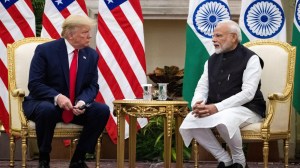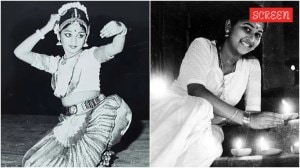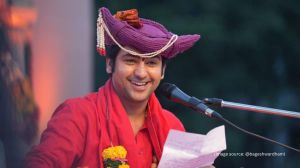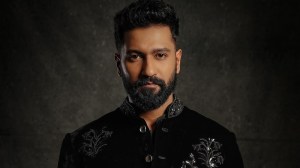Explained: Mythology, politics behind Gujarat’s Madhavpur Mela, and why CMs from Northeast are visiting it
Ever since the Gujarat govt took over the task of organising the Madhavpur Mela, the village panchayat's income has gone up manifold. Yet, some locals are not happy. What is the legend being the fair, and why is the state taking such an interest in it? We explain.
 At Madhavpur Mela in Porbandar on Sunday. (Photo: Chirag Chotaliya)
At Madhavpur Mela in Porbandar on Sunday. (Photo: Chirag Chotaliya)In his radio address programme Mann ki Baat last month, Prime Minister Narendra Modi had talked about Gujarat’s Madhavpur Mela, highlighting its links to Northeast India and terming this “deep bond between India’s east and west” part of our “heritage”.
The Mela was inaugurated on Sunday (April 10) by President Ramnath Kovind. Since then, Chief Ministers from the Northeast regions of the country and a host of Union Ministers have been visiting the fair, with Information and Broadcasting Minister Anurag Thakur saying, “In the entire country, there is no other fair which the President and host of Union Ministers and Chief Ministers of a number of states visit.”
As the Madhavpur Mela commences, sharing what I said during last month’s #MannKiBaat about this unique celebration of India’s cultural diversity and vibrancy. pic.twitter.com/6j8SWGMUJq
— Narendra Modi (@narendramodi) April 10, 2022
What is the Madhavpur Mela?
The Mela is a religio-cultural fair taking place every year in Madhavpur, a village on the Porbandar coast, also known as Madhavpur Ghed. The village has temples of Madhavraiji, or Lord Krishna, and his consort Rukmini, believed to have been built in the 15th century. It is also known for its sandy sea beach, the turquoise waters of the Arabian Sea, a sea turtle hatchery and the Osho Ashram
The fair begins on Ram Navami, Lord Rama’s birth anniversary falling on the ninth day of the month of Chaitra in the Hindu calendar, and culminates on Tryodashi, the 13th day of the month.
Mythology behind the fair
The fair celebrates the marriage of Lord Krishna with Rukmini around 4,000 years ago, as per Hindu mythology.
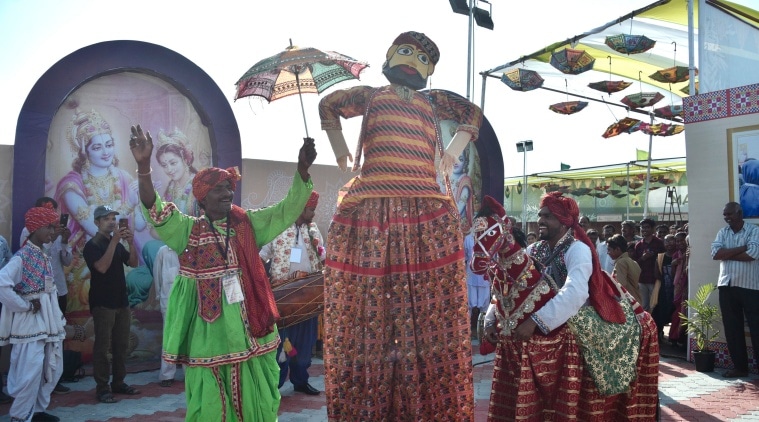 The fair begins on Ram Navami, Lord Rama’s birth anniversary falling on the ninth day of the month of Chaitra in the Hindu calendar, and culminates on Tryodashi, the 13th day of the month. (Photo: Chirag Chotaliya)
The fair begins on Ram Navami, Lord Rama’s birth anniversary falling on the ninth day of the month of Chaitra in the Hindu calendar, and culminates on Tryodashi, the 13th day of the month. (Photo: Chirag Chotaliya)
According to mythology, Lord Krishna had established his kingdom in Dwarka near Porbandar. Rukmini, daughter of King Bhimak of the present-day Arunachal Pradesh, wanted to marry Krishna, while her brother wanted to marry her off to Shishupal, Krishna’s cousin. Therefore, Krishna abducted Rukmini, brought her to Gujarat and tied the knot with her at Madhavpur village.
Today, to mark the wedding, marriage rituals go on for five days. They culminate with the idols of Lord Krishna and Rukmini being taken out in a procession through Madhavpur for ‘samaiya’, a ritual to welcome the bridegroom back home with his bride.
Significance and scaling-up of the fair
Gujarat is famous for its cultural fairs, such as the Tarnetar fair in Surendranagar and the livestock fair of Vautha in Dholka. Most of these fairs are held in monsoon and winter. The Madhavpur Mela, though unique as it is held in summer — the sea breeze in the coastal village saves it from the worst of the blistering heat – was till five years ago just one of the hundreds of fairs held in the state.
But in 2018, the state government, in collaboration with the Centre, took over its organisation, with an aim to highlight cultural connections of the Northeast with the western part of the country.
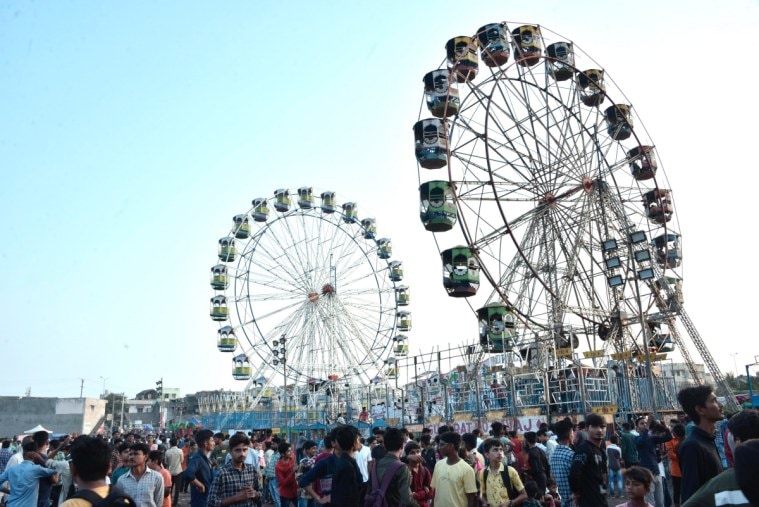 The Madhavpur Mela is unique as it is held in summer. (Photo: Chirag Chotaliya)
The Madhavpur Mela is unique as it is held in summer. (Photo: Chirag Chotaliya)
The government invited Governors and Chief Ministers of Northeastern states to the fair, along with art troupes from the region. A handicraft exhibition is also organised here, and the government presents the fair as an annual effort to integrate the culture of the Northeast with that of the west.
Till five years ago, the Mela was organised jointly by the Madhavpur village panchayat and the local temple administration on a 23-bigha plot known as ‘Mela nu Medan’, near Madhavraiji temple. But in 2018, the state took on rent farmers’ plots around the temple for a larger revelry.
This year, the government has taken on lease 41 bigha private land for creating parking lots, a helipad where five helicopters can land at a time, a stage for politicians to address the gathering, exhibition ground, etc. The government has also hired 100 public transport buses to ferry people of Porbandar, Devbhumi Dwarka, Gir Somnath and Junagadh districts to Madhavpur free of cost.
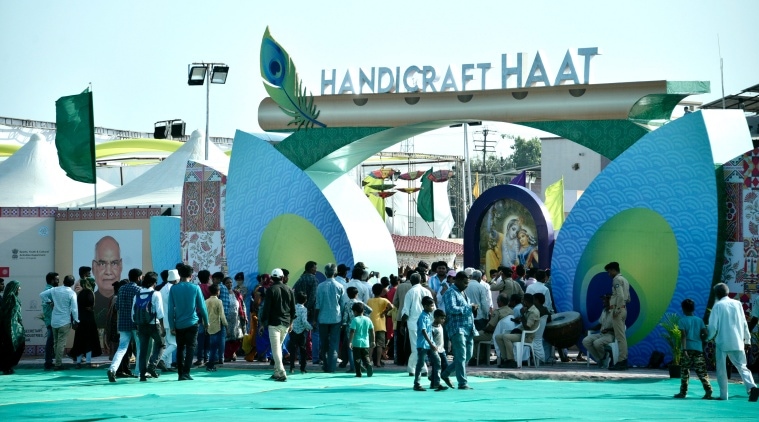 Gujarat is famous for its cultural fairs, such as the Tarnetar fair in Surendranagar and the livestock fair of Vautha in Dholka. (Photo: Chirag Chotaliya)
Gujarat is famous for its cultural fairs, such as the Tarnetar fair in Surendranagar and the livestock fair of Vautha in Dholka. (Photo: Chirag Chotaliya)
Fair’s economy
Earlier, the Madhavpur village panchayat would earn around Rs10 lakh to Rs15 lakh per year by auctioning off space for stalls on the Mela nu Medan. Visitors would mostly be people from villages surrounding Madhavpur.
But since the government took over, the village panchayat’s revenue has increased manifold. In 2022, the government leased land from farmers for some days and gave it to the village panchayat for auction. The panchayat generated Rs35 lakh by auctioning off 98 plots for various rides and stalls. Locals selling food items and soft drinks also do swift business.
However, farmers whose land is taken on lease lose their standing summer crops. The low-lying coastal plain known as Ghed, which includes Madhavpur, remains flooded during monsoon. Therefore, only winter and summer crops are possible in Madhavpur. When The Indian Express visited the fair ground, alfalfa crops could be seen on one portion of the fair ground. The state compensates farmers for this crop loss. While the compensation rate for this year has not been fixed, sources said the figure of 2018, which was Rs 12,000 per bigha, is likely to be used as the template.
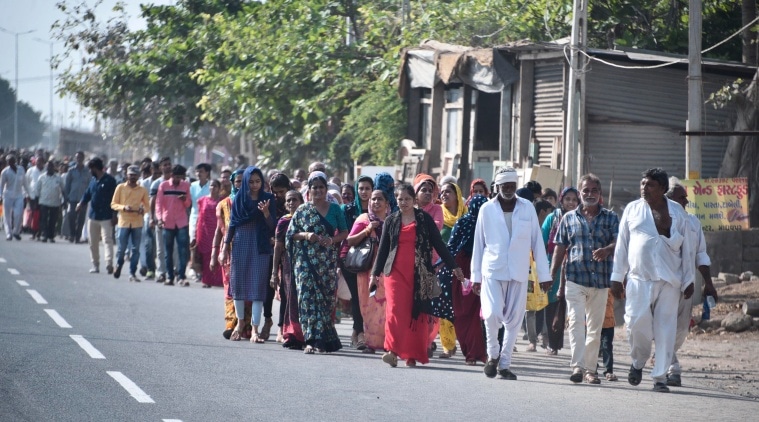 The Mela was inaugurated on Sunday (April 10) by President Ramnath Kovind. (Photo: Chirag Chotaliya)
The Mela was inaugurated on Sunday (April 10) by President Ramnath Kovind. (Photo: Chirag Chotaliya)
Role of the panchayat
Since the government took over the task of organising and managing the fair, the panchayat’s role is becoming irrelevant. At the inauguration of the ongoing fair on April 10, no one from the panchayat was given a seat on the dais.
“The panchayat is getting more revenue, but people of Madhavpur are not happy because the religio-cultural fair has been turned into a fair of politics with little regard to traditions,” complained Bhanu Bhuva, incumbent sarpanch of Madhavpur.
Arvind Raiyani, Gujarat’s Minister of State for Transport and Tourism, disagreed. “This is a place of heritage value, requiring the government’s intervention for its development. Of course it has to be done by taking the village panchayat along, and we are doing that. We had sent invites to everyone but people are not turning up due to differences in ideologies,” Raiyani claimed, adding the government’s objective was to make the fair a national event and highlight the importance of the Madhavraiji temple.
Importance in state politics
Madhavpur is the biggest village of Porbandar district, with 13,000 voters. Till 2002, it was part of Mangrol Assembly seat, a Congress bastion. In 2007, it was made part of Kutiyana Assembly seat. The BJP, which has been in power in Gujarat for the past 27 years, had won Kutiyana seat for the first time in 1998 and held it for the next two terms. In 2012, strongman Kandhal Jadeja of NCP won it and retained it in 2017.
Newsletter | Click to get the day’s best explainers in your inbox



- 01
- 02
- 03
- 04
- 05













